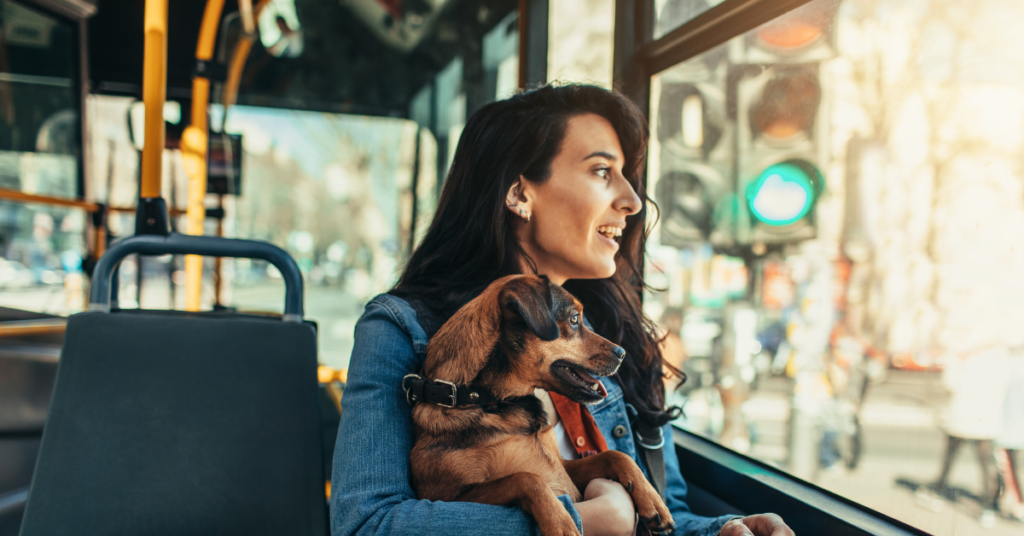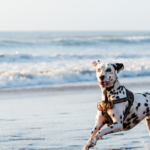Yes, You can take your dog on a bus, but rules vary by transit system. Most buses allow service animals without restriction, while pet dogs often must ride in a secure carrier or stay on a short leash. Size limits, fees, and seating restrictions may apply, so always check local transit policies.
What Does The Law Say In The U.S.?
The Americans with Disabilities Act (ADA) requires public transit to allow trained service dogs. Emotional support animals (ESAs) are not classified as service animals under ADA. For non‑service pets, each agency sets its own rules. That is why you might ask, “Can I Take My Dog on a Bus?” and get different answers in different cities.
- Service dogs must be under control and housebroken.
- Transit staff may ask if the dog is a service animal and what tasks it performs.
- They cannot ask for papers or require vests.
I use this baseline whenever I plan a trip. It keeps me clear on what must be allowed by law and what is optional policy.
Why Policies Differ By Bus Type
“Can I Take My Dog on a Bus” depends on whether you ride city buses or intercity buses. City systems often allow small pets in secure carriers. Many intercity companies still allow only service animals.
City Transit Vs. Intercity Services
City buses aim for short trips and high turnover. That makes carriers a common rule for pets. Intercity trips are longer, with luggage and limited space, so many companies restrict pets to service animals only. This split is the core reason people ask Can I Take My Dog on a Bus so often.
How To Prepare Your Dog For A Bus Ride
I treat bus rides like a new skill. I start small, make it positive, and focus on calm behavior. Evidence shows dogs adapt better to new environments after gradual exposure.
Action steps:
- Practice with the carrier at home for 10–15 minutes daily.
- Reward quiet settling with treats.
- Introduce bus-like sounds at low volume. City buses can reach 70–80 dB, so ear acclimation helps.
- Do a short, off-peak ride first.
- Bring a familiar blanket or toy to lower stress.
“Can I Take My Dog on a Bus” becomes an easy yes when your dog is trained to relax in a carrier.
Must-Know Rules By Major U.S. Bus Operators
I reviewed current public policies in 2025–2026. Always check your local operator on the day you travel, because policies update.
- New York MTA: Pets allowed in carriers that fit on your lap; service animals allowed.
- LA Metro: Pets must be fully enclosed in carriers; service animals allowed.
- Chicago CTA: Small pets in carriers; service animals allowed.
- SF Muni: Small pets in carriers; service animals allowed.
- WMATA (DC): Pets in secured carriers only; service animals allowed.
- Greyhound: Service animals allowed; pets not allowed.
- Megabus US: Service animals allowed; pets not allowed.
- FlixBus US: Service animals allowed; pets not allowed.
Tip: Screenshot the policy to show a driver if asked. This quick step answers the Can I Take My Dog on a Bus question at the stop, fast.
Safety, Health, And Etiquette Backed By Research
I focus on comfort and sanitation because studies link calm handling to better outcomes in transport. Dogs show fewer stress signs when travel routines are predictable and carriers are familiar. Good etiquette helps everyone.
- Health: Keep vaccines up to date. Core vaccination helps protect your dog and the public.
- Hygiene: Line the carrier with a leak-proof pad. Bring waste bags and hand sanitizer.
- Behavior: A quiet dog in a closed carrier is rarely a problem.
- Timing: Travel off-peak to reduce noise, crowding, and heat.
- Space: Keep the carrier on your lap or under your seat if rules require it.
This approach makes Can I Take My Dog on a Bus safe for my dog and considerate for others.
Step-By-Step: Boarding Day Checklist
I keep this list on my phone so I never forget the basics.
- Confirm the operator’s pet policy that morning.
- Pack: collapsible water bowl, sealed treats, waste bags, wipes, travel-sized sanitizer.
- Carrier: well-ventilated, escape-proof, labeled with your name and phone.
- Exercise: 15–20 minutes of light play or a walk before departure.
- Potty break: 10 minutes before boarding.
- Seating: Choose a spot away from doors and loud joints if possible.
- Calm cue: Teach “settle” at home so you can use it on the bus.
If you follow this, the answer to “Can I Take My Dog on a Bus” feels like a confident yes.
Common Mistakes To Avoid
I see the same preventable problems. Avoid them to protect your trip.
- Skipping the carrier on systems that require it.
- Using a carrier your dog has never practiced in.
- Traveling during rush hour with a reactive dog.
- Letting the dog block aisles or seats.
- Forgetting ID tags and your phone number on the carrier.
“Can I Take My Dog on a Bus” gets messy when I ignore even one of these.
Traveling With Service Animals Or ESAs
I want this part to be crystal clear. Service animals trained to do tasks for a disability must be allowed under ADA. ESAs are not service animals under ADA and follow pet rules.
- Staff may ask: “Is the dog a service animal required because of a disability?” and “What task is the dog trained to perform?”
- They cannot request paperwork.
- A disruptive or unsafe animal (aggressive, not housebroken) may be removed, even if it is a service animal.
If you ask “Can I Take My Dog on a Bus” for an ESA, the answer depends on the carrier’s pet policy.
Cost, Equipment, And Training Tips
I keep expenses low and focus on comfort.
- Carrier: Choose one that’s breathable, secure, and the right size (dog can stand, turn, and lie down).
- Comfort: Add a washable pad and a soft familiar cloth.
- Training: 10 minutes/day of carrier time for one week reduces stress signs for many dogs.
- Budget: Expect $25–$80 for a good soft-sided carrier.
This practical setup makes “Can I Take My Dog on a Bus” smooth and affordable.
FAQ’s
Do All Buses Allow Dogs?
No. City buses often allow small dogs in enclosed carriers. Many intercity buses allow only service animals. Always check the specific operator.
Can I Take My Dog on a Bus Without A Carrier?
Usually no for pets. Most city systems require carriers. Service dogs do not need carriers but must be under control.
Are Emotional Support Animals Allowed Like Service Dogs?
No. ESAs follow pet rules. Only trained service dogs are protected by ADA on buses.
What Size Dog Can Ride On A City Bus?
Policies vary. Many allow any dog that fits in a fully enclosed carrier on your lap or under your seat.
How Do I Keep My Dog Calm On The Bus?
Practice with the carrier, travel off-peak, use a familiar blanket, and reward quiet behavior. Short practice rides help a lot.
Can I Take My Dog on a Bus For Long Trips?
Intercity companies often allow service animals only. For pets, consider car travel or pet-friendly rail options where available.
What If Another Rider Has Allergies?
Stay in your carrier zone, keep the dog contained, and offer to move if the driver suggests it. Policies usually prioritize containment.
Wrap-Up
You asked, “Can I Take My Dog on a Bus?” The short answer is yes—often for city buses with a carrier—and always for trained service dogs under ADA. The longer answer depends on the operator. Check rules, prep your dog, and carry the right gear.
Start small this week. Pick one quiet route, bring the carrier, and try a short ride. You’ll build your dog’s confidence and your own.
Want more tips like this? Subscribe, share your experience in the comments, and tell me which city you plan to ride next.
I’ve loved dogs all my life and have cared for many different breeds over the years. Here, I share simple tips, stories, and helpful advice for all dog lovers. Whether you’re a new pet parent or a lifelong dog fan, you’ll find something useful and fun on my site.


